2D MXenes Ink: Synthesis, Properties, and Their Precursors
Anupma Thakur, Srinivasa Kartik Nemani, Brian C. Wyatt, Babak Anasori
Department of Mechanical and Energy Engineering and Integrated Nanosystems Development Institute (INDI), Indiana University-Purdue University Indianapolis, Indianapolis, IN 46202
MXenes and MAX Phases: A Diverse Family of 2D Materials and Their Precursors
Since their discovery in 2011,1 two-dimensional (2D) transition metal carbides and nitrides known as MXenes have been explored in various applications including energy storage, catalysis, selective adsorption/filtration, electronics, sensing, electromagnetic interference shielding (EMI), antennas, and biomedical applications.2 This 2D material family has been continuously expanding with more experimentally realized and computationally predicted compositions demonstrating unique structure-property behaviors.2,3 MXenes are made via a top-down synthesis approach by selective etching of certain atomic layers of their precursors, mostly MAX phases. MAX phases are represented by the chemical formula Mn+1AXn, where M is an early transition metal (green in Figure 1), A represents an A group element (red in Figure 1), and X represents carbon or nitrogen (grey in Figure 1).4 MAX phases are machinable layered carbides and nitrides with some compositions that are resistant to chemical attack and high-temperature oxidation.5,6,7 Resistance to oxidation with aluminum-containing MAX phases as the A group, such as Ti2AlC and Ti3AlC2, is due to the formation of Al2O3 as a protective oxide scale as a result of Al diffusion out of the MAX phase structure at high temperatures.8,9 Figure 1 represents the elements that have been reported in the MAX phase chemistry. The lanthanides are the latest addition to the MAX phase family that opens the possibility of synthesizing magnetic MAX phases.10
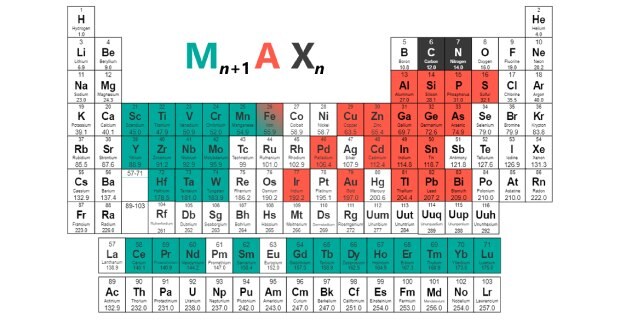
Figure 1.The elements reported in the chemistry of MAX phases in the literature. M (in green) corresponds to the transition metal occupying the M sites in the structure. A (in red) represents the A-layers in the MAX structure that must be selectively etched to synthesize MXenes. X (in dark grey) represents the non-metal element carbon, nitrogen, or a combination of both occupying the non-metal sublattices. Most of the compositions of the MAX phases can be found in ref4.
In the MAX phase layered structure, the Mn+1Xn layers are interleaved with the A layers. The M-A bonds are weaker than the M-X bonds.11 This weaker bonding allows selective etching of the A layers by breaking the M-A bonds via topochemical etching methods to synthesize MXenes. Because MXenes are made via the top-down selective etching process, the Mn+1Xn composition, phase purity, flake morphology, and MXene properties are dependent on the quality of the precursor MAX phases. Figure 2 shows the synthesis of MXenes from their corresponding MAX phases, the M2AX (sometimes referred to as two-one-one, or 211), M3AX2 (referred to as three-one-two, 312) and M4AX3 (four-one-three, 413). The red atoms represent the A-layers which are selectively etched in aqueous media with fluorine-containing acids, such as hydrofluoric acid (fluorine atoms are shown in yellow). After the selective removal of the A-layers, the outer transition metal (M) layers in Mn+1Xn are commonly terminated by –F, –O, –Cl, or –(OH), which are shown as Tx in the MXenes’ Mn+1XnTx formula.11 The presence of these functional groups on the basal planes of MXenes (the top and bottom exposed M layers) makes them highly hydrophilic with high negative surface charges (~ -30 to -60 mV) in aqueous as well as in a wide range of protic and aprotic solvents.12
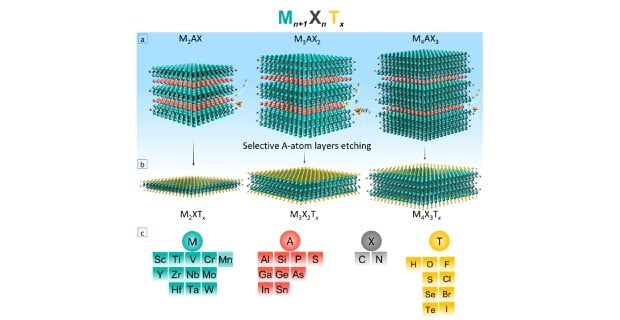
Figure 2.The selective etching of the A-layers from the MAX structures (a) to form MXene flakes (b), (c) the elements of M, A, X, and T in MAX phases and MXenes. Horizontal bars on Mn indicate that Mn-containing MAX phases have been synthesized, but MXenes containing Mn have not yet successfully been synthesized. M5AX4 and its corresponding MXene are not shown for simplicity.
Wet-chemical etching routes in fluoride-containing acidic solutions are the most used method for synthesizing MXenes. The etchant solutions are usually hydrofluoric acid (5 to 50% HF), a mixture of hydrochloric acid (HCl) and HF, and in situ HF formed by mixing a fluoride salt (e.g., LiF) with HCl. HF-free methods such as molten salt (such as, ZnCl2, NiCl2, CuCl2, SnF2, KBr, CdBr2, and CdCl2), electrochemical, and halogen etching routes have also been explored as alternative methods of etching MAX phases to synthesize MXenes. These methods can also give more control over the surface termination compositions, add new elements like T, and form MXenes with uniform surface termination compositions. For example, MXenes with uniform surfaces of T, Se, Br, or I are identified and reported by molten salt methods.13,14 However, aqueous etching methods are used to make MXene colloidal solutions (MXene inks) as described in this article. Prior to discussing MXene inks, this paper will first examine a selection of MAX phases and their corresponding MXenes, summarizing their properties along with a few of their applications.
Ti2AlC/Ti3AlC2 MAX phases and their Ti2CTx and Ti3C2Tx MXenes
MAX precursors of the two widely explored MXenes Ti2CTx and Ti3C2Tx are Ti2AlC and Ti3AlC2, respectively.15,16 Ti2AlC consists of Ti:Al:C mixed in a stoichiometric ratio of 2:1:1 while the Ti3AlC2 is formed when Ti:Al:C are present in a ratio of 3:1:2. Oxidation stability at high temperatures (≥ 1200 °C) of these MAX phases and their potential application as heating elements have been investigated.8,9 As for oxidation resistance, Ti2AlC performed better than Ti3AlC2 because of the former’s higher aluminum content, which leads to the formation of a dense protective oxide scale of Al2O3. Even before the discovery of MXenes, high-temperature studies of MAX phases indicated that the removal of the A-elements from MAX structures leaves behind the MX compositions.
Ti3C2Tx MXene was the first reported MXene (2011) and has been explored for various applications ranging from energy storage, catalysis, EMI shielding, biomedical, additive manufacturing, and printing.1,3 Ti3C2Tx MXene has widely been utilized as electrode material in supercapacitors with reported electrical conductivities as high as 24,000 S/cm and a capacitance of 490 F g-1.17,18 Ti3C2Tx MXene is amongst the highly efficient EMI shielding materials with reported 99% shielding for a ~55-nm-thick film and better shielding effectiveness for films with submicron and a few µm thicknesses.19,20 Ti3C2Tx is also being studied for mechanical and tribological applications21 owing to its high in-plane stiffness (330 GPa)22 which is amongst the highest reported values for solution processable 2D materials synthesized via top-down processes.
Ti2CTx MXene is a thinner MXene composed of two M layers with a carbon layer in between, as compared with the thicker Ti3C2Tx consisting of three layers of M and two layers of carbon atoms. Thinner MXenes are predicted to exhibit higher gravimetric capacitance (charge stored per gram) due to low formula weights.23 Ti2CTx is also explored in lithium-sulfur batteries as a sulfur host, increasing the stability due to strong interactions between the polysulfide and surface terminations of the MXene.24 Ti2CTx, however, is a less stable MXene toward degradation compared to Ti3C2Tx, and has a higher propensity toward hydrolysis in aqueous media.25 Both these MXenes exhibit excellent solution processability, electrical conductivity, and high aspect ratios enabling them to be explored as printable 2D materials.26,27
Ti3AlCN MAX and Ti3CNTx MXene
The Ti3AlCN is a Ti-containing M3AX2 MAX phase similar to Ti3AlC2. However, in contrast to Ti3AlC2 which is a carbide, Ti3AlCN is a MAX phase in which carbon and nitrogen are mixed at the non-metal (X) sites.4 Ti3AlCN demonstrates better electronic and mechanical properties as compared to Ti2AlC and Ti3AlC2, with a Youngs’ modulus of about 11% higher than that of Ti3AlC2.28,29 By selective etching of the aluminum layers, the Ti3CNTx MXene can be synthesized.30 Ti3CNTx has been explored for optical31,32, energy storage (such as in Na-ion batteries),33 mechanical,34 and catalytical applications.35 More recently, the Ti3CNTx MXene was reported to be the most effective 2D material for EMI shielding, with an EMI shielding effectiveness (EMI SE) of 116 dB for a 40-µm-thick film after annealing at 350 ºC in a vacuum.36 Ti3CNTx is one of the lesser explored MXenes that is commanding a mounting interest, with approximately 16 studies published since the first report in 201230. Roughly 35% of these studies emerged in 2022 (based on Web of Science TM statistics), suggesting an increased focus on Ti3CNTx and carbonitride MXenes in general.
Ti2AlN MAX and Ti2N MXene
Another less explored MAX, Ti2AlN, is the counterpart of the Ti2AlC MAX phase with carbon replaced by nitrogen in the non-metal sublattice. The synthesis of Ti2AlN MAX phase requires the use of nitride powders, unlike the carbide phase at which graphite can be used as a source for carbon in the raw mixed powder used for the reactive sintering of the MAX phase. Two types of nitride powders have been used in the raw powder mixture for Ti2AlN reactive sintering: 1) AlN or 2) TiN.16,37 Ti2AlN, akin to its other MAX counterparts, has widely been explored as a conductive, oxidation-resistant, and lightweight nitride.38-40 Synthesis of Ti2NTx from the MAX phase is challenging, as the conventional HF etching route is detrimental to the structural integrity of the MXene. The presence of an additional electron with N, as compared to C in the non-metal (X) site of the MAX phase, decreases the stability (nominal stability range is between 3.6-4.5 electrons/atom) leading to a non-stable nitride MXene.11 Alternative processes such as molten-salt synthesis41 and mild etching routes42 using KF-HCl have been reported to be more efficient. Ti2NTx is yet to be explored to its fullest potential with growing interests for electrochemical,41 optical,43 and catalytic activity.44
Nb2AlC MAX and Nb2CTx MXene
The ternary Nb2AlC MAX phase consists of Nb-Al-C elements mixed in stoichiometric ratios of 2:1:1 synthesized via reactive sintering at 1600 ᵒC under argon flow or in a vacuum.45 The Nb2AlC MAX phase has exhibited paramagnetic properties under 5 mT and the corresponding MXene Nb2CTx shows diamagnetic behavior with a reversible transition to paramagnetism at higher magnetic fields.46 Nb2AlC can be etched via HF route (50% HF) usually in four days, indicating a higher exfoliation energy for Nb2AlC as compared to its Ti-containing MAX counterpart (Ti2AlC) that is usually etched in one day at a lower HF concentration.47 Nb2CTx has been studied for energy storage applications, and delaminated Nb2CTx MXene inks derived via amine routes exhibited better electrochemical behavior with a reported reversible capacity of 430 mAh g1 after 300 cycles.48
When Nb2AlC was etched via the molten-salt method, it resulted in the formation of Nb2CTx with a uniform surface termination, such as Nb2CCl2. Additionally, in the uniformly terminated Nb2CCl2, Cl terminations can be exchanged for other atoms to form a uniformly terminated MXene, such as Nb2CS2, Nb2CSe, Nb2C(NH), and Nb2COx. Out of these uniformly terminated Nb2CTx, three are identified as superconductive at Tc ~ 6.4 K (Nb2CS2), Tc ~ 4.5 K (Nb2CSe), Tc ~ 7.1 K (Nb2C(NH)).13 The Nb2CTx MXene has also been explored for biomedical applications. Nb2CTx MXene quantum dots are studied in-vivo for fluorescence imaging and metal ion sensing with biodegradability and photostability.49 The Nb2CTx MXene has shown efficacy towards tumor eradication via photothermal ablation route in NIR-I and NIR-II windows.50
Nb4AlC3 MAX and Nb4C3Tx MXene
Another ternary MAX phase of Nb and its corresponding MXene are Nb4AlC3 and Nb4C3Tx. The Nb MAX phase is comprised of M4C3 layers composed of four alternating layers of niobium atoms and three layers of carbon atoms.51,52 The Nb4AlC3 MAX phase was first reported in 200053 and its Nb4C3Tx MXene was etched and delaminated in 2014.51 Nb4C3Tx MXene has shown stable electrochemical performance as an anodic material with a specific capacity of 380 mA h g−1 at a current density of 0.1 A g−1.54 Nb4C3Tx is also the stiffest experimentally reported MXene with reported elastic moduli of ~ 400 GPa and is the highest among all solution-processable 2D materials.21,55
Mo2TiAlC2 MAX and Mo2TiC2Tx
The search for novel MXenes in the past decade has expanded the MAX family.4,56 In 2014-15, the search for possible synthesis routes of Mo-based MXenes revealed a new family of ordered double-transition metal MXenes.57 Mo2TiC2Tx and its MAX phase Mo2TiAlC2 were among those discovered phases in 2015 that are now part of a large subfamily of ordered double-transition metal MAX and MXene phases with in-plane and out-of-plane ordering of M elements.58,59 In the Mo2TiAlC2 structure, two layers of Mo atoms sandwich a layer of titanium atoms with carbon atoms occupying the nonmental octahedral sites.60 The Mo2TiC2Tx MXene can be synthesized via the typical HF etching57 and has been investigated for applications such as electrocatalysis, hydrogen evolution reaction (HER), and energy storage devices (supercapacitors, batteries, etc.).61 Because the basal planes of Mo2TiC2Tx are more catalytically active toward HER62, the Mo2TiC2Tx exhibits higher HER activity with lower overpotential (~248 mV at 10 mA/cm2) than its Ti-containing MXene counterpart, Ti3C2Tx (~400 mV at 10 mA/cm2). Furthermore, the surface functional groups (like hydroxyl, oxygen, and fluorine) potentially render MXenes as a promising filler for forming extensive hydroxyl networks in polymeric membranes that enhance the transfer of protons in proton exchange membrane-based fuel cells (PEM-FCs).63,64 These applications can benefit from using MXenes with different core transition metals.
Due to the aqueous synthesis method of MXenes and their negative zeta potential, the final product is usually in the form of stable colloidal inks. Consequently, MXene-based inks can be used in a variety of ink deposition techniques, such as 2D and 3D printing, spray, dip, and spin coatings, and stamping. The surface chemistry of MXenes influences the attractive forces within the dispersion and between the liquid and the substrate. Thus, it is important to understand MXene surface chemistry and its interaction with this solvent for the stability of the ink and printing processes. For large-scale applications, a controllable and scalable MXene-ink manufacturing and printing approach is needed. In this technical spotlight article, we cover the emergence of MXene-based inks, their printing and patterning methods, and the development of flexible devices to open new possibilities for the fabrication of wearable electronics, displays, electrodes, sensors, etc.
MXenes-based Inks
The development of advanced and smart devices has been influenced by the current rise in printable and flexible electronics. Printing technologies, as compared to conventional techniques such as vacuum deposition and photolithography, hold enormous potential in terms of rapid prototyping, flexibility, and eco-friendliness for large-scale and inexpensive fabrication of flexible electronics.65 The boon of printable electronics, which refers to the fabrication of electronic devices using printing technologies (namely patterning, inkjet printing, etc.), has recently attracted a lot of attention due to the development of solution-processed 2D nanomaterials. The blend of 2D materials and printing technologies started a decade ago in 2012 when the first graphene ink was inkjet-printed to fabricate field-effect transistors as flexible electronic devices.66
MXenes are particularly well-suited as printing and patterned coating inks because of their hydrophilic nature and colloidal stability in aqueous and organic dispersions.67 For example, Ti3C2Tx MXene dispersions exhibit strong stability in solvents with a high dialectic constant and inherent negative surface charge such as water, iso-propanol (IPA), dimethyl sulfoxide (DMSO), N,N-dimethylformamide (DMF), N-methyl-2-pyrrolidone (NMP), propylene carbonate (PC), and ethanol (EtOH) without the need to add any surfactants or additives.12,68 The use of different solvents can change the surface chemistry of MXenes, which in turn results in an alteration of properties such as morphology, rheology, concentration, and electrical conductivity. For example, the electrical conductivity of Ti3C2Tx MXene was reduced from ~2500 S/cm to ~333 S/cm when the solvent was changed from water to DMF.69 The high dispersion stability of water-based MXene inks contributes to environment-friendly printing by eliminating the use of surfactants. In addition to electrical conductivity, other properties such as viscosity, mechanical, and colloidal stability of MXene-based inks can be significantly influenced by tuning flake size, surface defects, and surface chemistry of MXenes. Various processing methods such as sonication, gentle stirring/ manual shaking, or intercalation with cations, anions, or molecules, have been used to further tune the quality, scalability, and characteristics of MXene-based inks.70,71
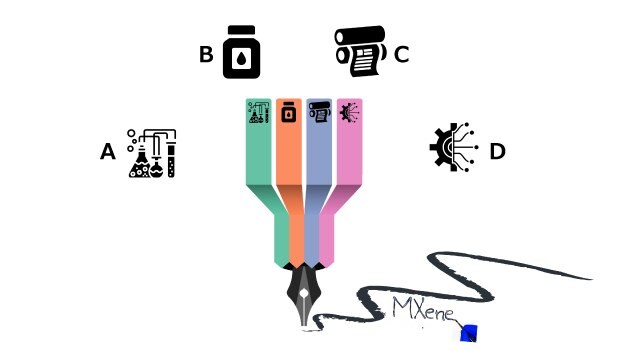
Figure 3.Illustration of the stages involved in printed/coated MXene-ink based devices: (a) MXene synthesis, (b) MXene ink preparation, (c) printing and coating techniques, and (d) fabrication of printed devices.
The quality of MXene ink depends on every step of MXene synthesis from the MAX precursor preparation, selective etching, and delamination of the etched MXene to the choice of solvent, rheology, flake size, and surface chemistry (Figure 3). In the precursor synthesis, high-quality and large MAX particles with minimal defects lead to larger MXene flake sizes with higher oxidation stability and electrical conductivity.12,71,72 The type of etchant in the selective etching is another key player that can control the flake size, flake surface chemistry, and quality. For example, HF etching and tetramethylammonium hydroxide (TMAOH) delamination results in smaller flakes (~few hundred nm) with more defects and higher content of fluoride-containing surface functional groups in Ti3C2Tx, whereas HCl-LiF etching and HF-HCl etching with LiCl delamination results in single-flakes with larger lateral sizes (~3-50 µm) and fewer defects.68,73
The use of intercalants such as organic molecules and cations controls the interlayer spacing of the multilayer MXene particles and affects the delamination process, which in turn determines the resulting MXene flake sizes and quality. For example, the use of organic bases, such as tetrabutylammonium hydroxide (TBAOH) and tetramethylammonium hydroxide (TMAOH), leads to intercalation of TMA+ and TBA+ and larger interlayer spacing. On the other hand, when metal cations such as Li+, Na+, and K+ are used as intercalants, they result in smaller interlayer spacing due to their smaller ionic radius. Intercalation of these cations also improves the electrical conductivity by increasing the carrier density in MXenes.
Furthermore, it is essential to note that the storage of MXenes plays a vital role in the stability of MXene-based inks. MXenes exhibit low chemical stability in aqueous environments as they tend to oxidize and react with water molecules, resulting in structural degradation and decreased electrical conductivity.74 Hydrolysis and oxidation reactions affect the stability of MXenes and tend to begin at surface functional groups, transition metal defect sites, and edges.75,76 The hydrolysis followed by the oxidation of MXene colloidal solutions is significantly flake size-dependent, with flakes of smaller sizes being less stable.25,77 Edge-initiated instability causes an accelerated degradation rate of smaller MXene flakes. Separating MXene flakes by size and using only larger flakes can increase the shelf life and improve the stability of MXenes aqueous solutions. Storage of MXene in organic solvents results in a slower oxidation rate when compared to water, suggesting that hydrolysis is the main reason for MXene flakes degradation.12 In addition, oxidation of MXenes can be mitigated by introducing antioxidants such as ascorbate and polyphosphoric anions.78 Storing MXenes aqueous solutions in freezing conditions (-20 °C or -80 ºC), argon-filled vials (5 °C), or embedding MXene flakes in polymer composites results in slower oxidation.77 These methods, along with the suitable tailoring of the composition of the precursor MAX phases, have improved the shelf life of MXenes from one week to six months.72,76 The oxidation of MXenes in dry forms, such as freestanding MXene films, is slower than in aqueous dispersions. The thermal annealing of freestanding MXene films under an inert argon environment induces surface modifications and the removal of intercalated species such as water, increasing the chemical stability of the films. Thus, the MXene-based films and printed devices have higher stability due to limited or no water molecule interaction, thereby minimizing the hydrolysis degradation of MXenes.79 These methods may be potentially used for improving the stability of MXene-based inks.
For printing applications, it is necessary to print MXene-based inks with nanometer to micrometer thicknesses using the MXene colloidal dispersions. Figure 4 depicts many printing and coating technologies that are investigated for printing MXene-based inks. The printing and patterning processes can be classified as either digital (such as inkjet printing, pattern coating, and 3D printing) or non-digital (such as ink writing, screen, and transfer printing) depending on whether a pattern/stencil/template is employed for MXene-based ink printing.80 In addition to these conventional printing procedures, a range of coating technologies, including Meyer rod coating, spray coating, spin coating, doctor-blade coating, as well as patterning strategies including masking and laser patterning, are utilized for MXene colloidal dispersion. Each of these printing techniques requires a certain fluid property and differs in printed resolution and scalability.81 To date, inkjet printing, screen printing, and 3D printing are the key methods employed for printing MXene-based inks.81
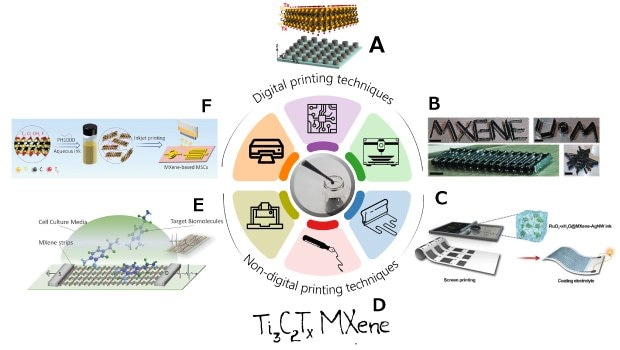
Figure 4.Representation of the printing and coating techniques using MXene-based inks, (a) patterned coating of MXene-inks on glass and alumina substrate (reproduced with permission82), (b) 3D printing of architectures (reproduced with permission 83), (c) screen printing of flexible MXene based supercapacitors (reproduced with permission 84), (d) ink writing using Ti3C2Tx MXene ink, (e) transfer printing of MXene-based field effect transistor for biosensing (reproduced with permission 85), and (f) inkjet printing of MXene-ink based self-powered integrated system (reproduced with permission 86). The “Ti3C2Tx MXene” at the bottom is a handwritten example with a MXene ink.
As a non-contact, digital, and high-resolution printing process, inkjet printing has been extensively utilized to fabricate a variety of devices including sensors and energy storage devices87,88. In many applications for inkjet printing, MXene aqueous ink titanium carbide (Ti3C2Tx) 927430 is widely used. The digital deposition process without a mask, the ability to print on various substrates (silicon, polymer, paper, etc.), and the ease with which micrometer-scale devices can be fabricated are benefits of MXene-based inkjet printing. In contrast to inkjet printing, screen printing involves depositing high-viscosity MXene-based inks onto substrates through a stencil screen. Screen printing heavily relies on the rheological properties of MXene inks89 and has the advantages of (a) thick printed patterning with a high aspect ratio, (b) low cost of processing, and (c) mass production.67 Additionally, 3D printing methods enable the digital fabrication of intricate 3D structures. A high-viscosity silicon oil-ligand matrix is extruded by 3D printers using negatively charged MXene-based inks with regulated flow rates.90 This high-concentration MXene clay or paste is primarily used for 3D printing. Because water is the base solvent in these MXene inks, they are easily dried and make quicker 3D printing possible.91 The benefits of MXene-based inks for 3D printing include (a) excellent control over the thickness and geometry of printed patterns, (b) exceptional printing flexibility, (c) cost-effectiveness, and (d) environment friendliness.
MXene ink printing techniques are low-energy processes that can prevent undesirable damage in MXene layers and interfacial defects/states formed by conventional high-energy processes such as evaporation and sputtering.92 The advantages of MXene printing assist in tailoring essential properties such as controlled transparency, sheet resistance, interlayer spacing, and surface chemistry for their potential application in electronic and optoelectronic applications (more recently referred to MXetronics).93,92 The printing aspect of MXene inks shows great potential as electrical contact materials and conductive fillers for the fabrication of electronic devices (e.g., thin film transistors, field effect transistors, complementary metal oxide semiconductor inverters, and wearable sensors).94,95 Owing to their unique properties including a large surface area, high electrical conductivity, tunable and active surface chemistry, and biocompatibility, MXenes are used in designing printable biosensors (e.g., dopamine, glucose, ascorbic acid, uric acid,)96, electrochemical sensors (e.g., phenols, sulfadiazine, lead, cadmium, hydrazine)97, gas sensors (e.g., acetone, ethanol, ammonia, nitrogen oxide, sulfur dioxide)98, and wearable sensors (e.g., human motions recognition, pulse, breathing).99
The Future of MXene-based Inks
To date, only a few printing techniques have been employed to deposit or pattern MXene-based inks for printable device development. Even though some of the reported devices have demonstrated strong performance, most of the efforts have been limited to laboratory-scale research activity, requiring scale-up for real-world applications. So far, the primary challenges presented by precise MXene-ink printing and its various methods are (a) the formulation of MXene ink and (b) the dynamics of solvent evaporation. Therefore, scalable MXene ink printing techniques present new opportunities for their use in flexible electronics and MXetronics. MXene-based inks are also exciting and attractive candidates for the fabrication of functional devices such as supercapacitors, batteries, transistors, smart sensors, and actuators.
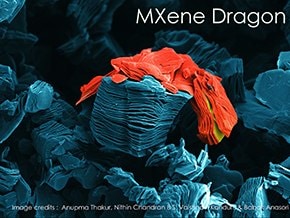
Read more about MXene applications in Material Matters 15.1 and R&D World Magazine.
Related Materials
References
1 - 20
21 - 40
41 - 60
61 - 80
81 - 99
To continue reading please sign in or create an account.
Don't Have An Account?